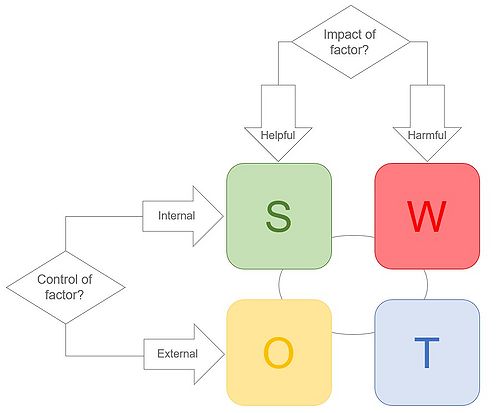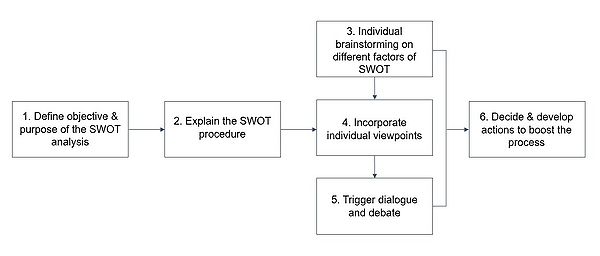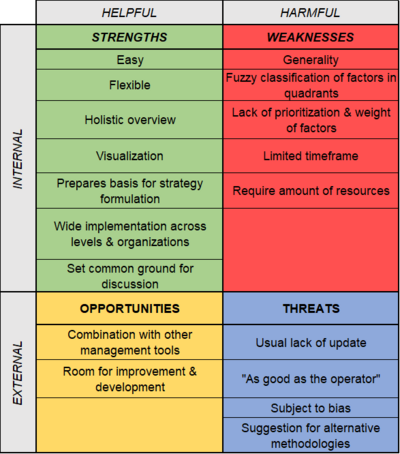SWOT Analysis Guide
Contents |
Abstract
SWOT consists a strategic management tool, mainly used to identify risks during the data analysis process. The acronym of the 4-box strategy development framework stands for Strengths, Weaknesses, Opportunities and Threats and is possible to be applied to different industries, such as commerce, production, planning and voluntary organizations. The first emergence of the term in the literature is traced back to 1960 to investigate what went wrong with corporate planning, funded by the Fortune 500 companies while creating a new system to support management change. Over the past decade, SWOT research has focused on analyzing organizations for recommended strategic actions.
As with every tool or technique, SWOT has also its advantages and limitations. On the one hand, it is an interactional analysis technique that makes macro evaluations possible, in a road from the general perspective and solutions to the more detailed, uncovering opportunities. On the other hand, it has been criticized as prone to bias with questioned validity due to the quantity of different identified factors or failure to easily include dynamic and structural changes in a world based on competition.
The following article aims to investigate the process of conducting a SWOT analysis through a literature review, in order to present a short guide for its implementation. By analyzing the potentials of this tool’s usage, some practical implications are presented, mainly relevant to the combination of SWOT with other strategic planning tools. In addition, the author’s reflections are presented in an attempt to discuss the value and potential improvements in the use of the tool.
Introduction
Strategic planning is a set of concepts, procedures and tools to be used in order for a company/organization to achieve its goals [1] and is a function of all managers at all levels of an organization. [2] While being a process that deals with the futurity of current decisions, it is also a bulwark to support strategic management. [2]
Strategic management is a continuous process of an organization to formulate and evaluate decisions and plans to achieve a competitive advantage by being proactive. [3] [4] The strategic management process is a sequential set of analyses and choices which includes the development of a vision and a mission, translated into a set of long-term objectives and followed by a strategy crafting to achieve the targeted performance. The next steps are the strategy’s implementation and execution as well as the necessary performance evaluation to review the situation and initiate corrective adjustments. [5]
Shedding light to the step of formulating a strategy, the implementation of a thorough external and internal analysis is involved. By conducting an external analysis, the organization is under a process of identifying potential threats and opportunities, focusing especially on the competition and customer analysis, respectively. [4] On the other hand, the internal analysis supports the organization to identify its strengths and weaknesses as well as its competitive (dis)advantages. The combined results are often summarized in a SWOT analysis, which consists a strategic management tool, mainly used to identify risks during the data analysis process. [4] [6] [7]
Based on the direct connection of SWOT with strategic management processes, an important notation is that the implementation of the tool does not lead itself to the development of a strategy. [8] An analysis interpretation as well as decision making, consist of independent steps to be followed by the stakeholders.
Historical development
The origin of SWOT analysis is difficult to be traced but the literature review places its emergence mostly back in the 1950s and 1960s in the Harvard Business School environment and mainly associated with Kenneth Andrews, Philip Selznick, Alfred DuPont Chandler and Harry Igor Ansoff. [9] [10] Although SWOT is highly related to the Harvard Business School, it is worth mentioning that Stanford Research Institute conducted research funded by several Fortune 500 companies in an attempt to boost planning practices and avoid failures. The results were classified into four categories, with a resulting acronym ‘SOFT’ derived from Satisfactory (S), Opportunity (O), Fault (F) and Threat (T). In 1964, Urick and Orr decided to replace Fault (F) for Weakness (W) and that led to today’s well-recognized acronym SWOT. [11]
Henry Mintzberg classified a preliminary form of SWOT as the main instrument of the Design School of Strategy and criticized the tool as an underlying cause to formalize the strategy-making process. [12] However, from the mid-’60s, Kenneth Andrews of Harvard Business School, in an attempt to combine competitive thinking with questions of strategy, created with his team the known SWOT analysis, supporting that the most suitable strategy is the one enabling harmonization between the different components of the matrix. [10]
Following the tool’s timeline, in the 1980s it was used to support SMEs to create business and market plans, while in the 1990s the tool was also used in the regional development processes, NGOs and projects’ formulation. After the 1990s, the need for the development of such analysis was revealed by criticisms, with a number of suggestions relating to the combination of SWOT’s usage with other analysis techniques such as Porter’s Five Forces Model, Cross Impact Analysis, etc. [10] During the years, ‘SWOT has essentially remained unchanged even though many models and frameworks have emerged - these are all variations on the same theme’. [11] Despite its different forms and development, it remains a fundamental strategic framework, which contributes to explore new possibilities and initiate new strategies.
The SWOT framework
The analysis of the future constitutes a process that intrigues individuals but also businesses and organizations. The implementation of SWOT analysis forms an alternative to evaluate results from present and future-oriented views. [13]
SWOT Analysis components
The acronym of the 4-box strategy development framework stands for Strengths, Weaknesses, Opportunities and Threats. It constitutes ‘a data gathering framework which records input factors’ (Sarsby, 2016). The most common template of a SWOT analysis is a 2x2 matrix where the rows distinguish between internal or external factors while the columns distinguish between helpful and harmful factors (depending on the context or objective of the analysis). As internal factors, strengths and weaknesses could be characterized as organizational, while the external factors (opportunities and threats) could be characterized as environmental. The SWOT matrix gives the opportunity to examine the interaction between the individual strengths and weaknesses of the system and the opportunities and threats of the future. Pairs of internal and external factors that ‘have the same cause most likely need similar or the same actions’. [13]

Strengths
Strengths are internal and helpful factors identified in the analysis objective. In this category, organizations might include financial strengths, technological advantages, customer services and human resources. [8] In general, the characteristics that render an organization more efficient and effective than competitors are included in its strengths. [10] In relation to the other matrix components, strengths could potentially support an opportunity or contribute to overcome a threat. [8]
Weaknesses
Weaknesses are internal and harmful factors identified in the analysis objective. In this category might be included financial struggles, dated technology, poor customer services and skill shortages related to human resources. Characteristics included in this category result in a lack of competencies and effective performance. Consequently, the identification of weaknesses is highly important as crafting a strategy based on a weakness could lead the company to ‘die quickly’. In relation to the other matrix components, weaknesses complicate the process of taking advantage of an opportunity and are factors more vulnerable to threats. [8]
Opportunities
Opportunities are external and helpful factors, lacking the possibility of control, but if handled right may result in desired results. Opportunities may arise from different resources such as trends, innovations, etc. [8] Regarding the relation with the other matrix components ‘opportunities are conditions in the external environment that allow an organization to take advantage of organizational strengths, overcome organizational weaknesses or neutralize environmental threats’ (Harrison & St. John, 2004: 164).
Threats
Threats are external and harmful factors, over which there is no control. [8] In relation to the other matrix components, they constitute a risk for opportunities or even organizational strengths.
Context of use
SWOT analysis is the commonest practical analytical tool for strategic planning, which is used by executives and consultants in different organizations as it is a simple and structured approach to evaluate a company’s strategic position and competitive advantage. [14] In the form of brainstorming sessions, the tool could be characterized as a dynamic process for decision-making under a specific context, as a Strength in one case could be a Weakness in another. [11] [8] The context and the purpose play a vital role in the SWOT analysis. [8]
Despite a company’s size and general characteristics, there are different general guidelines proposed in the existing literature related to steps and rules to be followed to extract the maximum outcome during a SWOT analysis.

The general steps are described in an attempt to provide a general flow model of SWOT analysis: [11]
- Define clearly the main objective and purpose of the analysis: failure to correct identification may lead to resource waste.
- Explain procedure to different stakeholders: as long as the objective is approved by all stakeholders, there is a need to communicate the tool’s nature to set a common ground in the team.
- Brainstorm individually and list, in a 2 by 2 matrix, the organization’s strengths, weaknesses, opportunities and threats: ask participants to work individually in a worksheet to record strengths, weaknesses, opportunities and threats the organization is facing currently. Help questions could be: What do we do well? What could we improve? What trends could you take advantage of? What is your competition doing?
- Combine individuals' worksheets in a common document: incorporate all responses in a common worksheet and distribute it to each participant.
- Trigger team’s communication through dialogue and debate related to each item’s classification: facilitate strategic dialogue to explore reasons behind individuals’ viewpoints and reach a decision.
- Develop and decide particular actions to forward the process.
Besides the above-described procedure, in order to produce dynamic results through a SWOT analysis, a number of ‘rules’ to be followed, during each step, are presented below: [14]
- Focused SWOTs: thoroughly defined evaluated area to maximize the productivity of the analysis.
- Shared vision: idea polling, reveal team consensus, team communication and agreement.
- Customer orientation: include in the evaluation of strengths and weaknesses, resources or capabilities recognized by the interested customer.
- Environmental analysis: include in the identification of opportunities and threats relevant to the customer.
- Structured strategy generation: after the completion of the matrix investigate matching, conversion and creative strategies.
Discussion
Advantages
Although an assessment of SWOT’s effectiveness is not an easy task, due to its numerous advantages, SWOT has been characterized as ‘the most widely used strategy tool in modern times’. [8] [11] More specifically:
- It consists a simple technique as its implementation does not require in-depth scientific knowledge. [14]
- It is a flexible model which can incorporate corporate or market information systems on request. [14]
- Easy method to structure complicated information such as qualitative and quantitative data, etc. [14]
- The field of application covers many levels of an organization (from an individual to a corporate strategy) and different depths of analysis. [8]
- Its visualization facilitates a holistic overview of the process and further communication of it with interested participants. [8]
- It can be used as a guide to build on strengths, correct weaknesses, recognize and exploit new opportunities and protect against threats.
Disadvantages & Limitations
Despite its advantages based on its simplicity and the variety of collective information included, SWOT had also received a significant amount of criticism. A few of these include:
- Prompt to bias matrix completion due to individuals’ perceptions, beliefs and preferences. [8]
- A pool of data collection without separating analysis elements and their evaluation, resulting in a long list. [8] [12]
- Tool usage has become ‘sloppy and unfocused’ (Piercy & Giels, 1989).
- Lack of prioritization or weight of identified of factors, giving the same importance to all of them. [12]
- There is not a requirement to support statements with data. [12] Consequently, it is also possible to list the same factor as a strength or weakness, depending on the viewpoint.
- As SWOT records facts of a specific timeframe, there is a need for updates to maintain and develop the analysis.
Reflections
The following figure is an attempt to implement a SWOT analysis for the SWOT analysis tool, to reflect on the value of its usage. While classifying the factors in the four quadrants, strengths such as ‘visualization’ and weaknesses such as the difficulty of brainstorming whether a factor is a strength or weakness, became clearly apparent.
References
- ↑ Bryson, J.M. (2003). Strategic Planning and Management. In B. Guy Peters and John Pierre, Handbook of Public Administration, pp. 38- 47, London: SAGE Publications Ltd
- ↑ 2.0 2.1 Steiner, G.A. (1979). Strategic planning: What every manager should know. A step-by-step Guide. New York: Free Press
- ↑ David, F.R. (2003) Strategic Management-Concepts and Cases (9th Edition). USA: Pearson Education
- ↑ 4.0 4.1 4.2 Dyer, J.H, Godfrey, P., Jensen, R., Bryce, D. (2017). Strategic Management: Concepts and Cases (2nd Edition). USA: Wiley.
- ↑ Preble, J.F. (2003). Integrating the Crisis Management Perspective into the Strategic Management Process. Journal of Management Studies, 34(5), pp. 769-791. doi: 10.1111/1467-6486.00071
- ↑ Helms, M.M. and Nixon, J. (2010). Exploring SWOT analysis – where are we now? A review of academic research from the last decade, Journal of Strategy and Management, 3 (3), pp. 215-251. https://doi.org/10.1108/17554251011064837
- ↑ Project Management Institute, Inc. (2017). Guide to the Project Management Body of Knowledge (PMBOK® Guide) (6th Edition), pp 414. Project Management Institute, Inc. (PMI). Retrieved from https://app.knovel.com/hotlink/toc/id:kpGPMBKP02/guide-project-management/guide-project-management
- ↑ 8.00 8.01 8.02 8.03 8.04 8.05 8.06 8.07 8.08 8.09 8.10 8.11 8.12 8.13 Sarsby, A. (2016). Swot Analysis: A Guide to Swot for Business Studies Students. United Kingdom: Spectaris Ltd.
- ↑ Madsen, D.Ø. (2016). SWOT Analysis: A Management Fashion Perspective. International Journal of Business Research, 16 (1), pp.39-56. doi: 10.18374/IJBR-16-1.3
- ↑ 10.0 10.1 10.2 10.3 Araştırmalar Dergici, U.S. (2017). SWOT Analysis: A theoretical review, The Journal of International Social Research, 10 (51), pp. 994-1006. doi: 10.17719/jisr.2017.1832
- ↑ 11.0 11.1 11.2 11.3 11.4 11.5 Chermack, T.H, Kasshanna, B.K. (2007). The Use and Misuse of SWOT Analysis and Implications for HRD Professionals, Human Resource Development International, 10 (4), pp. 383-399, doi: 10.1080/13678860701718760
- ↑ 12.0 12.1 12.2 12.3 Hill, T., Westbrook, R. (1997). SWOT analysis: It's time for a product recall, Long Range Planning, 30 (1), pp. 46-52. doi: 10.1016/S0024-6301(96)00095-7
- ↑ 13.0 13.1 Züst, R., Troxler, P. (2006). No More Muddling Through. Dordrecht: Springer.
- ↑ 14.0 14.1 14.2 14.3 14.4 Piercy, N., Giels, W. (1989). Making SWOT Analysis Work, Marketing Intelligence & Planning, 7 (5/6), pp. 5-7. doi: 10.1108/EUM0000000001042
